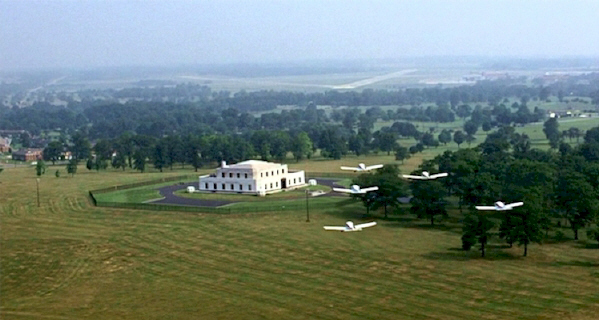 |
 |
| Flying over the Bullion Depository (this was the actual building at Fort Knox, not a set). | |
Goldfinger at Fort Knox
Stripes at Fort Knox
compiled by Geoff Walden
Update October 2018 ... Maybe I should have called this page "Hollywood at Fort Knox," because I am adding the film "Stripes" (1981) to the page, but I will also be adding James Bond in Las Vegas in "Diamonds Are Forever" (1971). To go directly to the "Stripes" section, click here.
Fans of James Bond films know that Goldfinger (1964) was partially filmed at Fort Knox, Kentucky. This webpage shows some of the film scenes, identifying their locations and comparing to what those locations look like today.
In the movie’s basic plot, the villian Goldfinger plans
to detonate a small atomic device (a “dirty bomb”) inside the U.S. Bullion
Depository at Fort Knox, making the gold reserves radioactive for several years,
thus bringing chaos to world financial markets and greatly increasing the value
of his own personal gold supplies. Goldfinger plans to reach the Bullion
Depository (Gold Vault) and put “Operation Grand Slam” into effect by
neutralizing the military force of soldiers stationed at Fort Knox with nerve
gas, sprayed from the air by his personal pilot’s fleet of airplanes – Pussy
Galore’s Flying Circus.
As Pussy Galore’s Flying Circus approaches the Bullion Depository from the southeast, they fly over North Dietz Acres military housing area at Fort Knox, then toward the Depository.
 |
 |
| Flying over the Bullion Depository (this was the actual building at Fort Knox, not a set). | |
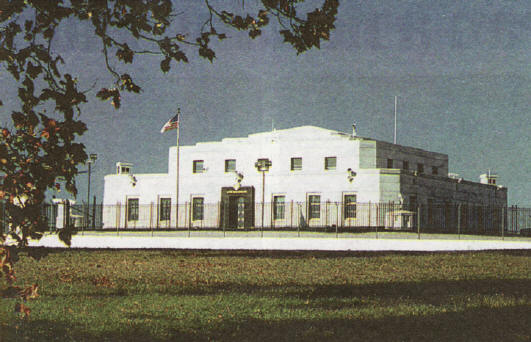
The U.S. Bullion Depository at Fort Knox (Elizabethtown News-Enterprise)
 |
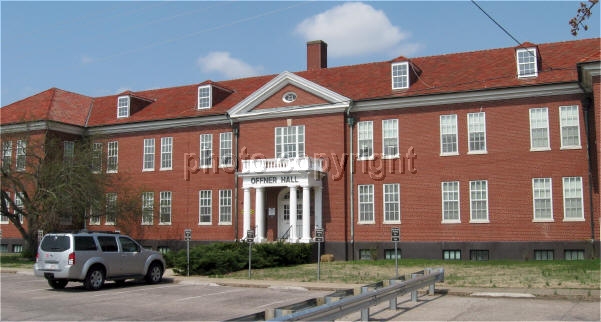 |
| As the planes break formation just after flying over the Depository, Offner Hall (Bldg. 5101) can be seen in the background. | |
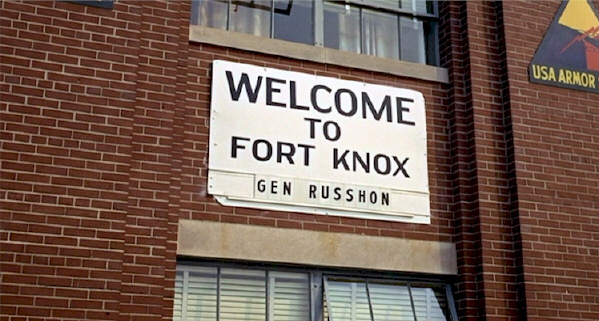 |
 |
| The next scene is the main aircraft hangar on Godman Army Airfield, Cairns Hall, Bldg. 5220. The sign for the fictional “Gen. Russhon” was added for the film. Russhon was actually the name of the film's technical adviser and military liaison, Charles J. Russhon. | |
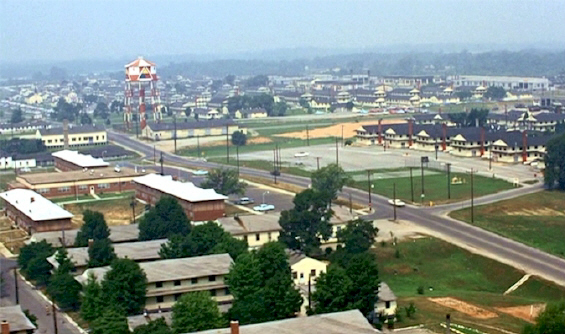 |
 |
| This view is looking roughly west along Brave Rifles Regt. Ave., toward the water tower at the intersection of Old Ironsides Ave. The World War II era wooden buildings seen in the film clip are all gone now, replaced by brick barracks and office buildings. | |
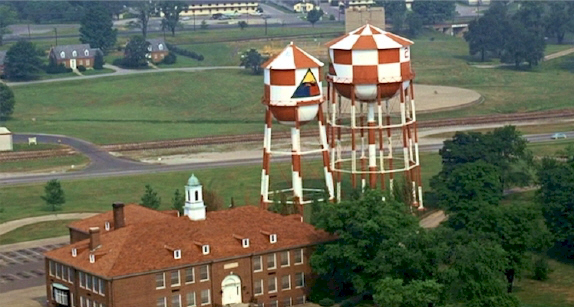 |
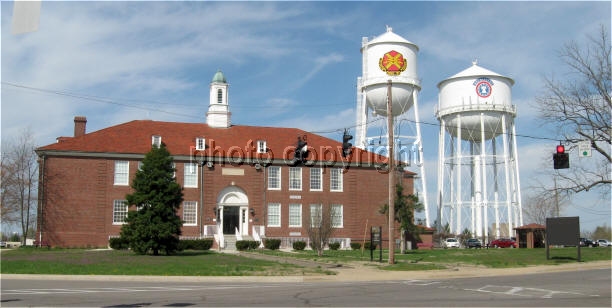 |
| The planes next flew past Briscoe Hall (Bldg. 1174) with its adjacent water towers. The gray building just behind the larger water tower is seen in the next screen shot. | |
Next the planes flew over a group of wooden troop billets, which were torn down several years ago.
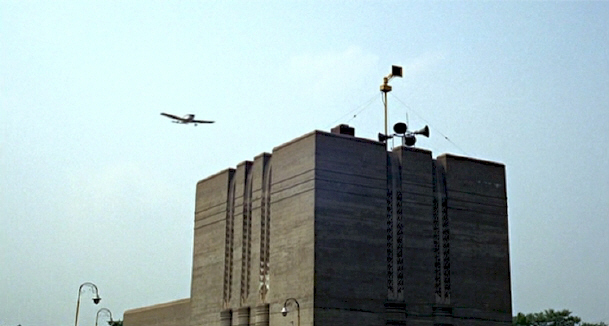 |
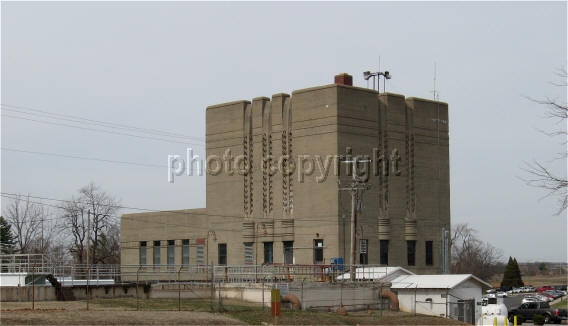 |
| This building (Bldg. 1205) houses part of the Fort Knox water distribution system. It was built in the 1930s in an art deco style – the concrete sides are decorated with cascading waterfalls. | |
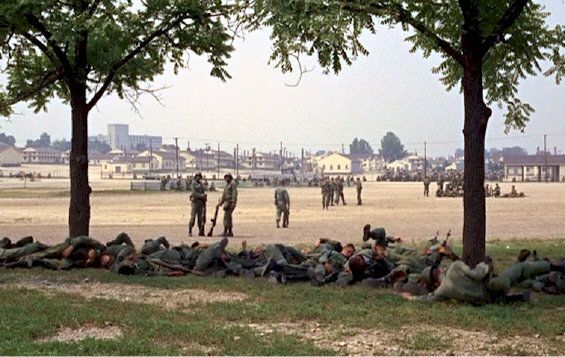 |
 |
| Ireland Army Community Hospital (Bldg. 851) appears in the background of this scene. | |
The planes next flew over a motor pool which was probably St. John Tank Park (Bldg. 2958).
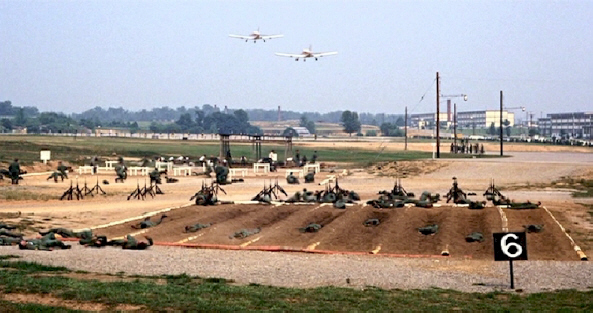 |
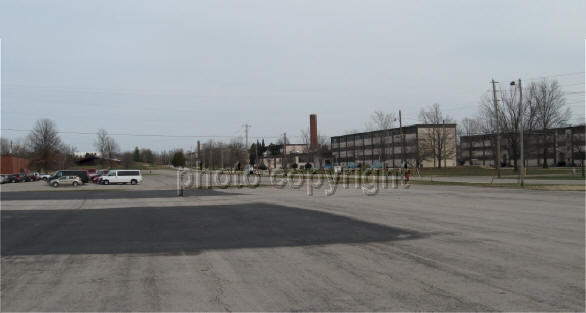 |
| The buildings seen in the right distance may be these buildings along Second Dragoons Rd. | |
The planes again flew over wooden troop buildings which are no longer there.
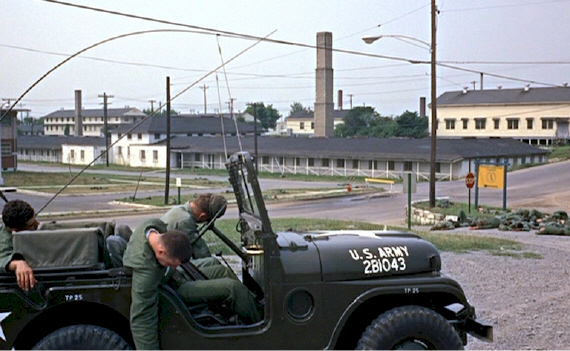 |
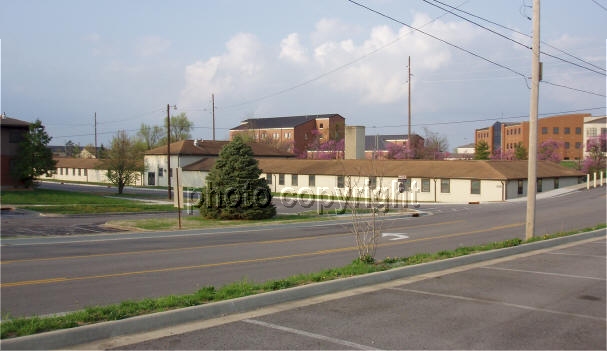 |
| This scene was taken on Brave Rifles Regt. Ave. at the intersection of Maronde St. The building seen today at the intersection ( Bldg. 2421) appears to be the original building which has been remodeled. The lower part of the heating system chimney still sticks out of the roof. Note: This building was torn down ca. 2014, and this is now a grassy lot. | |
Convoy
Scenes
Goldfinger’s convoy starts in a hidden position, then drives into Muldraugh, a small town just north of Fort Knox. Despite showing Bond in one of the trucks, Sean Connery was not in this filmed convoy. According to internet sources, Sean Connery did not travel to the United States for any scenes shot in this country.
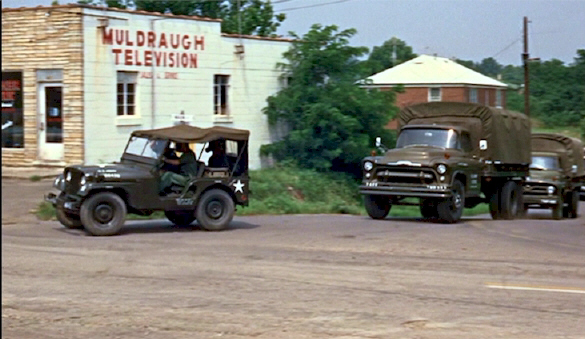 |
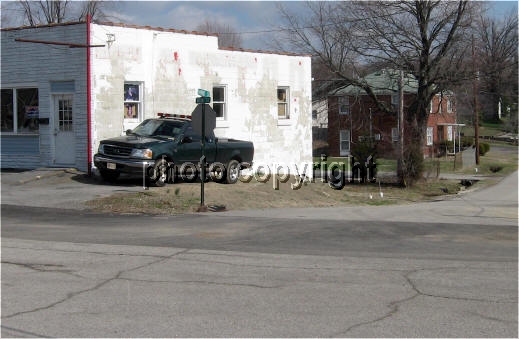 |
| The convoy drove up Harris St. in Muldraugh, and turned right onto Main St. (Ky. Hwy. 868). | |
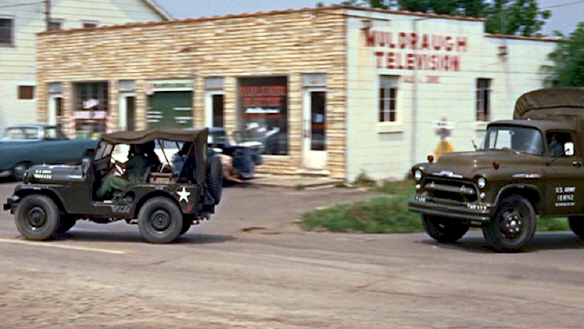 |
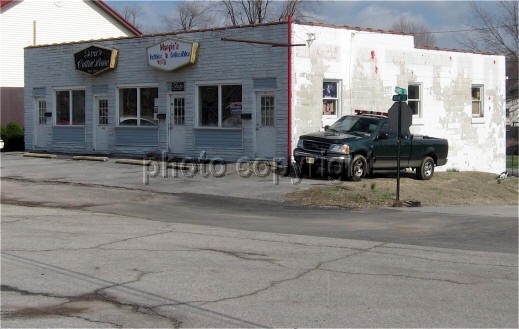 |
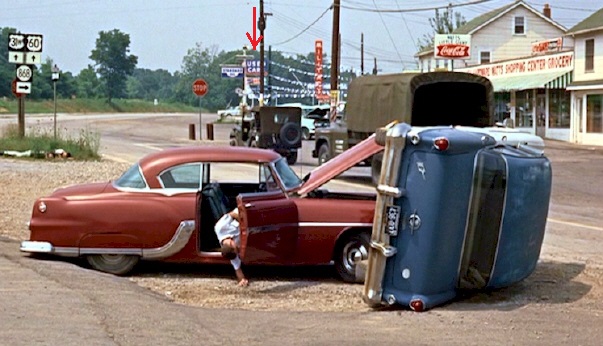 |
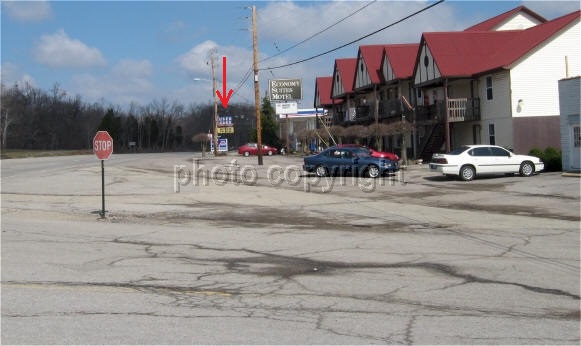 |
| The convoy continued on Main St. in Muldraugh to US Hwy. 31W "Dixie Highway," where they turned the wrong way to go to Fort Knox (they turned north toward Louisville). | |

The Used Cars sign is the original as seen in the film
(arrowed in the photos above, in the
center distance).
Note: Sometime between 2011-2016 this sign was covered
with a plastic sign in the same style.
 |
 |
| The convoy is now on post,
driving east on Brave Rifles Regt. Ave.,
past the water tower at the intersection of Old Ironsides Ave., then
past the intersection of Maronde St. (below). Note: The building with the chimney was torn down ca. 2014, and this is now a grassy lot. |
|
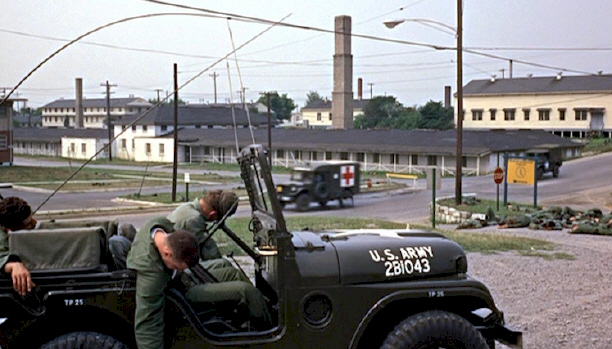 |
 |
The convoy is then seen turning onto Famous 4th Div. Rd., from Eisenhower Ave. (the wooden buildings seen in the background are no longer there).
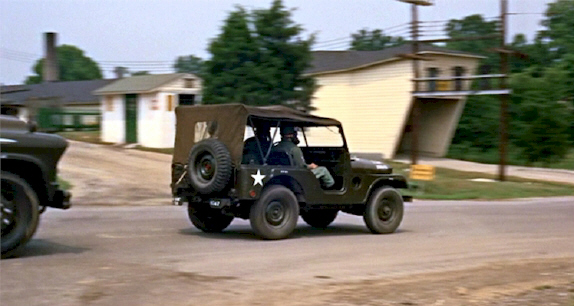 |
 |
| The convoy passes the historic LST Building (Austin Hall, Bldg. 1538). This structure was built during World War II to test design modifications of LST ships (Landing Ship, Tank), and was later used to allow tank crews to practice driving off a landing craft ship. It is one of the few original World War II wooden buildings preserved at Fort Knox today. The convoy continues north on Famous 4th Div. Rd. (actually driving away from the Bullion Depository area). | |
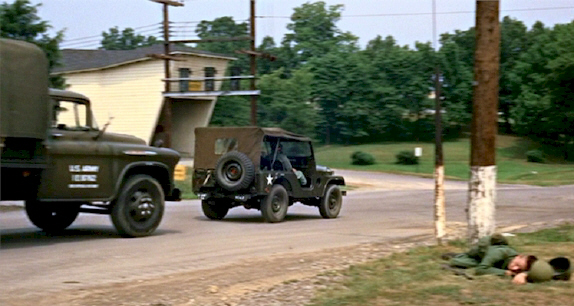 |
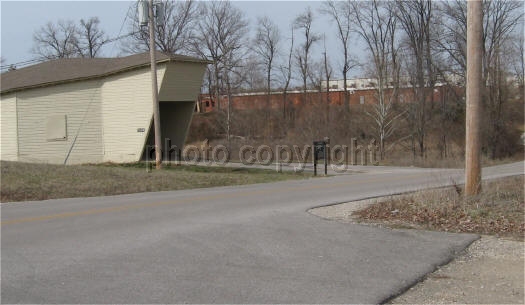 |
In the next scene, the convoy is turning into the Depository drive – from here on, none of this was filmed at Fort Knox. Despite the clever street signs – Bullion Blvd. and Gold Vault Rd. - this approach drive and all the subsequent scenes showing the Depository (inside and out) were filmed on sets in England.
Note – Some references have reported that the “Kentucky Fried Chicken” street scene, where Felix Leiter and his fellow CIA agent watch Oddjob drive past Joe’s Drive-In, was filmed in either Louisville or Lexington, but it was actually filmed in Opa-Locka, FL (north Miami area). An Opa Locka Blvd. street sign is visible in the scene showing the Joe’s Drive-In sign. (As an aside, the first time the agent looks at the tracker screen, while Leiter is inside KFC, the map location is just off Lower River Road near Meadowlawn, KY, just southwest of Louisville. For the next tracker screen scene, the location has moved north up US Hwy. 31W to about West Pages Lane, in Pleasure Ridge Park. When Leiter loses the signal after Oddjob’s car is crushed, the screen moves from Hwy. 31W south of Pleasure Ridge Park, to a location that is now the south end of Louisville International Airport (Standiford Field).
The Gold Vault Model
A model of the Bullion Depository, displayed in the Patton Museum at Fort Knox, is said to have been the original used in Goldfinger, when Goldfinger briefs his fellow criminals on “Operation Grand Slam.” Actually, it appears that more than one model was used in the film, and although the museum model may not be the more detailed model that can be seen in close-ups, it is apparently another model that was also used.
This model does not appear to be the main model that was used in the briefing – the model that Bond hides beneath while he eavesdrops on Goldfinger’s plans, and is seen through the model windows during a close-up view. The joints between the stones of the walls cannot be seen in the museum model, the doorway is shaped differently and lacks the legend UNITED STATES DEPOSITORY in gold letters over the door, as seen on the film model (and the real Depository), the corner towers are different, and other details do not match this model seen in the film.
However, the Depository model that appears in the background as Goldfinger describes his plans to dynamite the electrified fence around the compound, may be the model that is now in the Patton Museum. Its doorway appears more like this model, and it appears to lack the UNITED STATES DEPOSITORY legend over the door. At any rate, the filming of these models was not done all in one take, or possibly even during the same shoot, since the model cars change location between scenes, and the model trees are shaped differently in different scenes. It is entirely possible that different Depository models were used as well.
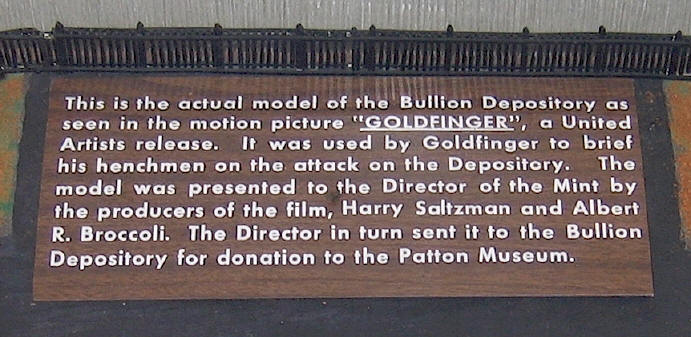
The marker that is displayed with the model now in the Patton Museum at Fort Knox.
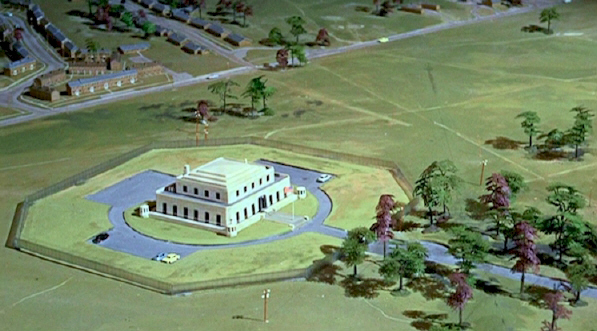 |
 |
| On the left are views of the main model seen in the film. On the right are comparison views of the model on display in the Patton Museum. The base of the model is obviously different, but there are also differences in the main doorway, corner towers, and other small details. | |
 |
 |
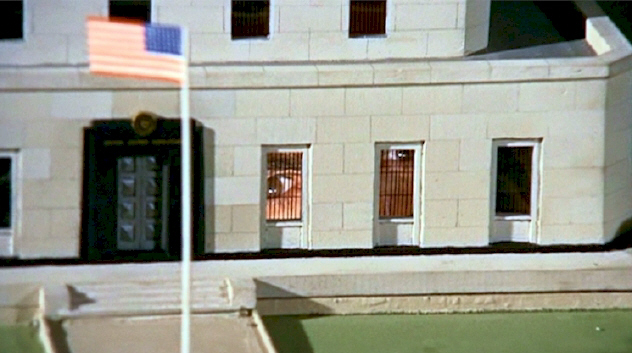 |
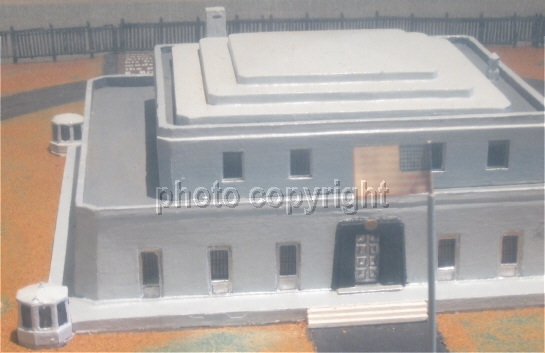 |
| The differences in the models are particularly evident as the camera zooms in on the film model, as Bond looks out the windows from his hidden position beneath the model. The model used for this scene in the film is much more finely detailed, and is a more faithful representation of the actual building, than the Patton Museum model. Note the dividing lines between the building stones and the words UNITED STATES DEPOSITORY above the doorway on the film model, which cannot be seen on the museum model. Also, the shape of the doorway is different. | |
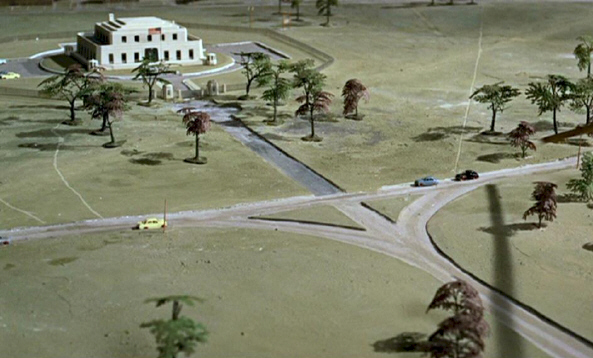 |
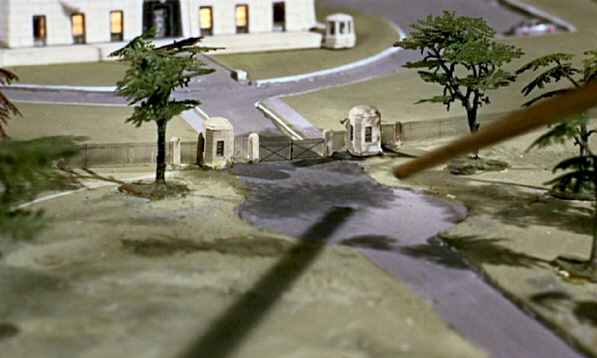 |
| This is the Depository model that appears in the background as Goldfinger describes his plans to dynamite the electrified fence. It may be the model that is now in the Patton Museum. Its doorway appears more like this model, and it appears to lack the UNITED STATES DEPOSITORY legend over the door. Compare to the close-up of the museum model just above. | |
Stripes at Fort Knox
Although it may seem strange, given the theme and content of the film, the U.S. Army fully cooperated with the filming of Stripes (1981), and most of the film was shot at Fort Knox, Kentucky, which was the home of the Armor Center and School when the filming took place there in December 1980.
Starring primarily Bill Murray, Harold Ramis, Warren Oates, and John Candy, Stripes follows the antics of a platoon of misfit recruits as they go through basic training, followed by a special assignment with Top Secret equipment. Most of the filming at Fort Knox took place among the World War II era wooden barracks buildings in the basic training complex. These buildings were all torn down ca. 2005 to make way for the Gen. Timothy Maude Human Resources Command center. However, a few buildings seen in the film still remain at Fort Knox today.
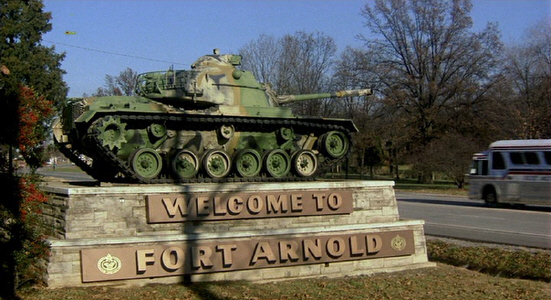 |
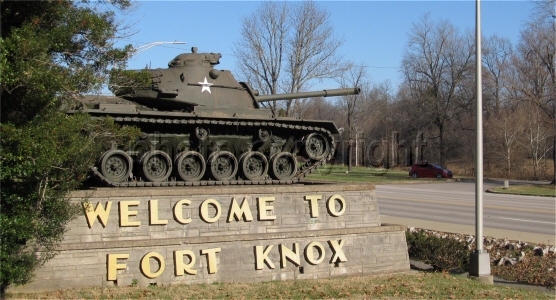 |
| Fort Knox stood in for the fictional Fort Arnold of the film. In 1980 this was the Chaffee Gate, the main entry gate to Fort Knox. After 9/11 the main entrance to Fort Knox was changed to a different gate, and the Chaffee Gate is no longer an entry gate, but the "Welcome to Fort Knox" sign remains with the M48A2C tank. | |
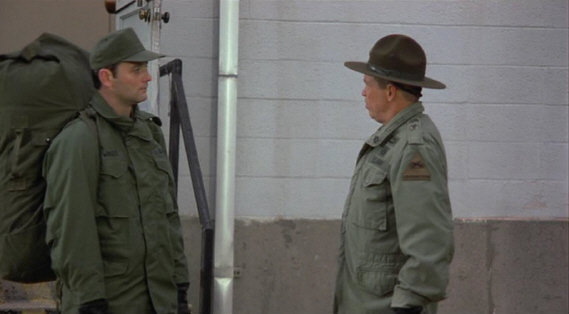 |
 |
| Following the scene where the
new recruits get their G.I. haircuts (well, some of them ... of the
actual stars, only John Candy got a real recruit haircut), they go to
the Central Issue Facility (CIF) to draw their Army uniforms. As the
recruits leave the CIF building, Sergeant Hulka (Warren Oates) chews out
recruit Winger (Bill Murray) for always being last (Hulka was an SFC -
Sergeant First Class - Drill Sergeant). Oates was a Kentucky native and
was said to have enjoyed the filming at Fort Knox.
This scene was filmed at the side of Bldg. 6569, which was the actual CIF building at the time, and for many years after that (the building is not in service now). The doorway used in this scene was the doorway on the right in the photo below. |
|
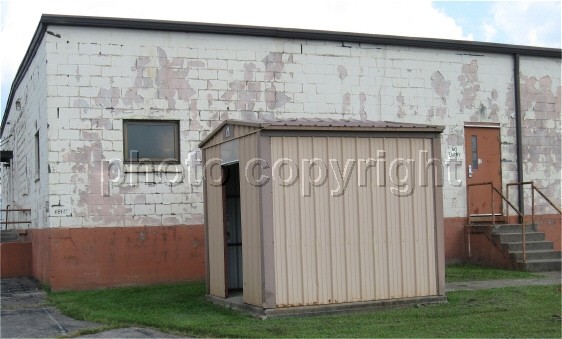 |
|
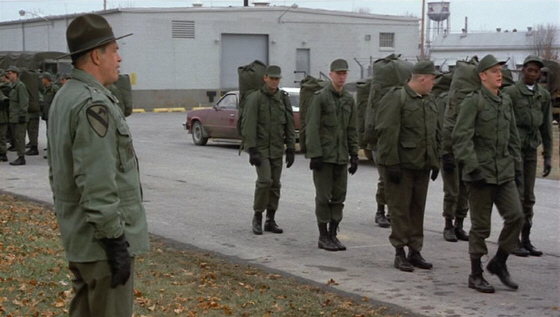 |
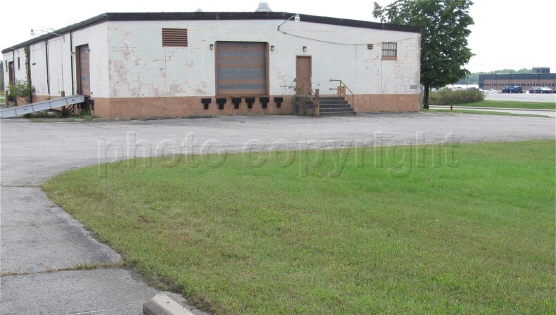 |
| Drill Sergeant Hulka lines the
recruits up in front of the adjacent building, before they march off
singing "Doo Wah Diddy Diddy."
Bldg. 6570 is hardly changed, except for paint. The light fixtures, barred window, vent, and even the T-shaped loading dock bumpers are all the same. |
|
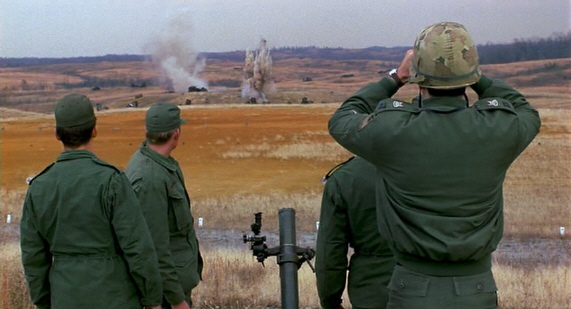 |
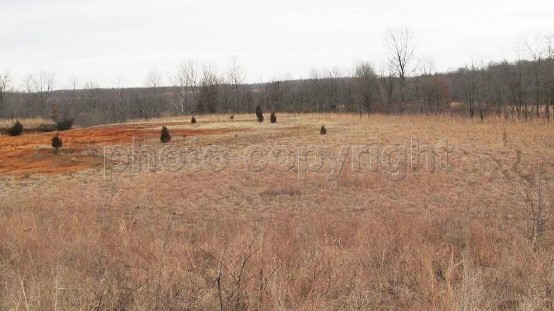 |
| Captain Stillman (John
Larroquette), the bumbling training company commander, observes a
platoon firing on the mortar range. He orders a recruit mortar crew to
fire their mortar even though it has not been properly laid on target.
This scene was filmed at Garvin Range, which was a mortar range for many years (this webpage author fired mortars on this range in 1978). The foreground still looks very similar, but trees have grown up in the middle distance over the years, obscuring the impact area where the mortar rounds landed, along with the tank targets. |
|
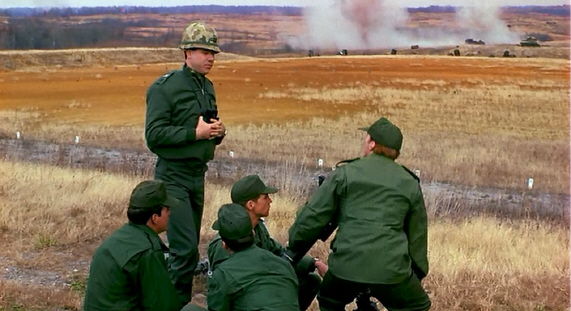
|

|
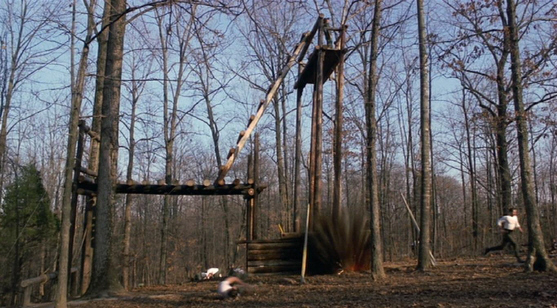 |
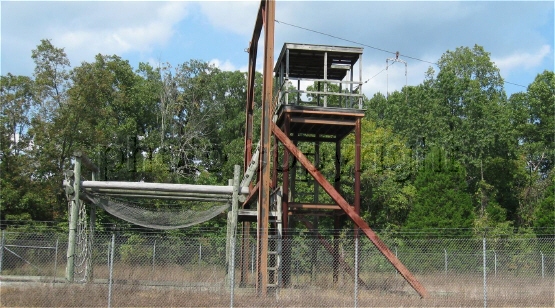 |
| The errant mortar round hits
at the base of an obstacle course climbing tower, with SFC Hulka on top
of the tower. The tower collapses, injuring Hulka and taking him away
from the rest of basic training.
This is obviously not the same tower, but it may be in the same or a nearby location. The now-unused Grabiarz Confidence Course is located in the woods near the tower (which also appears to be unused now). |
|
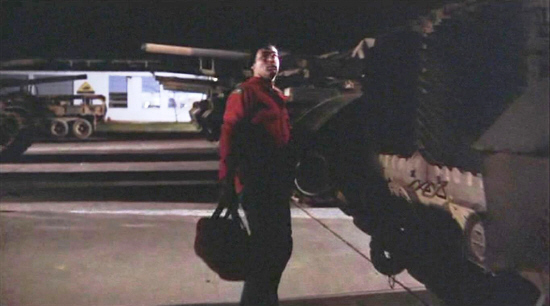 |
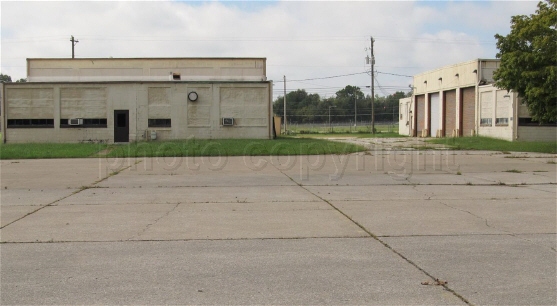 |
| Winger (Bill Murray) is fed up
with life in basic training and decides to sneak off and go AWOL (Absent
Without Leave) one night. He sneaks into a tank park where he is stopped
by his friend Russell (Harold Ramis), and they are returned to their
barracks by friendly MPs (Military Police, played by P.J. Soles and Sean
Young).
This was filmed in Potts Motor Pool, the tank park for the 1st Armored Training Brigade of the Armor School. Judging from the expansion joints in the concrete, the building seen here in the modern photo (Bldg. 6145) was the same building in the background while Winger was sneaking around among the tanks (M60A1 model). Potts Motor Pool is no longer used on a regular basis, but occasionally for visiting units. |
|
|
|
|
|
After the recruits finish basic training, they are assigned to a Top Secret mission testing the "EM-50 Urban Assault Vehicle" in Italy. Through a series of bumbling maneuvers they end up crossing into Czechoslovakia by mistake. Winger and Russell, who had stolen the EM-50 and gone AWOL to Germany, along with Sergeant Hulka and the friendly MPs, rescue the platoon and lead them back across the border, with hilarious results both coming and going. In the scene below, the EM-50 is leaving Czechoslovakia following the rescue, about to crash through a temporary guard shack erected in the road after the border guard building seen above had been destroyed. The "Czech Army" trucks at the border were actually U.S. Army M561 "Gama Goat" 6x6 carriers. The "Czech border" was created at a site just north of the Fort Knox post, along the original Louisville & Nashville Turnpike at a historic iron railroad trestle dating from 1873. This trestle was replaced by a modern concrete structure in 2012. Today this site is the beginning of the "Bridges to the Past" historic trail and Tioga Falls scenic trail, off U.S. Highway 31W near West Point, Kentucky. |
|
|
|
|
|
|
|
|
From the border, the action moves to a Soviet military
post inside Czechoslovakia, where the platoon is being held prisoner.
These scenes were filmed at the Chapeze distillery at Limestone Springs
near Clermont, Kentucky, about 23 miles from the previous filming
location. Although this distillery is no longer in operation but used as
a storage area by Jim Beam (in nearby Clermont), the distinctive
half-timbered distillery office building, the water tower, and a few
older buildings remain on the site. Most of the buildings seen in the
background of the film scenes have been torn down and replaced by more
recent bourbon rickhouses. In the scene above, the EM-50 is approaching
a small iron bridge that leads into the distillery area (the Soviet
post). |
|
|
|
|
|
|
|
|
Above, the "Gama Goat" and EM-50 arrive on the Soviet post after crossing the small iron bridge. Note the tank parked in the right background - this tank will soon play a big part in the action. This area has changed very little, with a guard rail to keep vehicles off the bridge today. Below, Winger (Bill Murray) distracts the Soviet guards with a bottle of vodka, in front of the distillery office building. |
|
|
|
|
|
|
|
|
Driving past and behind the distillery office, the EM-50 approaches the location where the platoon is being held prisoner, where Murray's and Soles' characters will exit the EM-50 and go inside the Soviet compound to rescue the platoon. The iron bridge can be seen in the background of both shots. The metal buildings on the right are no longer there. |
|
|
|
|
|
While Murray's and Soles' characters rescue the platoon, Ramis' and Young's characters drive around in the EM-50 trying to get away from a Soviet tank. In the process, a Soviet gunner in a tower fires a cannon at the EM-50, but its miraculous armor saves it from destruction. The tower was built for the film, adjacent to the distillery office building, and is no longer there. |
|
|
|
|
|
|
|
|
The rescued platoon members find that the EM-50 has moved, so they go looking for it. The large metal building is no longer there, but the concrete curb seen near the edge of the creek is the original, and the same tree with two trunks is still there. Below, the platoon members sneak along the side of the metal building, when suddenly a Soviet tank comes around the corner in front of them. If you look closely you can see two Soviet guards standing on top of the brick building above the tank - this spot is still there. |
|
|
|
|
|
|
|
|
The "Soviet" tank was actually a U.S. Army M60A1 tank from Fort Knox with a few modifications to make it look more Soviet. The EM-50 backs around the corner to come up behind the Soviet tank. The building in the background is now gone, but the other two buildings show almost no changes. |
|
|
|
|
|
|
|
|
The EM-50 comes up behind the tank (it can be seen just behind the tank in the view at left above) and knocks it out with its gun, after which the tank crashes into a building. This was either an old distillery building or a building that was built at the site to be purposely destroyed during the filming. This building sat where the much smaller metal building is seen below to the side of the old brick distillery building. The old distillery office building can be seen in the background of both scenes (just above the tank in the scenes above). |
|
|
|
|
|
|
|
|
After the tank is destroyed, the rescued platoon members get in the EM-50 (a militarized recreational vehicle) while Ramis' and Murray's characters provide covering fire from the rear ramp. The old brick distillery building is still there, but unused and much the worse for wear now. |
|
|
|
|
|
The EM-50 with all aboard crosses back over the iron bridge, crashes through a barrier, and leaves the Soviet compound. The tower with the cannon that shot at the EM-50 can be seen in both of the film stills. In 1992 the iron bridge was named the Bruce Harned Memorial Bridge (no longer open to traffic). |
|
|
|
|
I wish to thank Matt Rector, Cultural Resources Specialist at Fort Knox, for assistance with information used for this webpage.
Modern photographs (except the Bullion Depository), layout, and all text copyright 2011-19, Geoffrey R. Walden, all rights reserved. All the screen shots from the film Goldfinger are copyright Danjaq LLC and United Artists Corporation. “James Bond” copyright Ian Fleming Publications. All screen shots from the film Stripes are copyright Columbia Pictures Corporation.